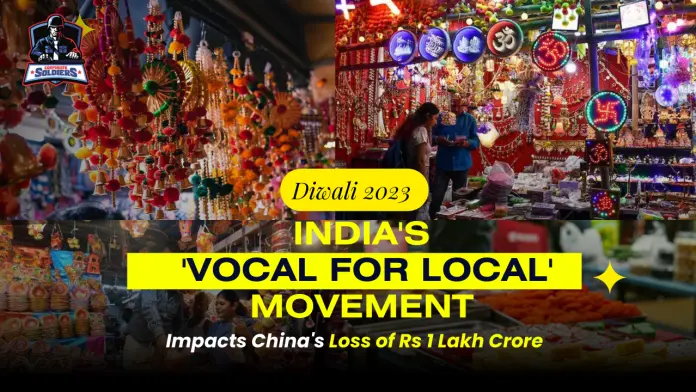Data from CAIT shows that India’s record turnover was Rs 3.75 crore. Kartik Pournima is predicted to hit the 4.25 crore mark. According to CAIT Chief Secretary Praveen Khandelwal, China suffered a loss of Rs. 1 lakh crore on Diwali this year. Chinese products used to control 70% of the Indian market during Diwali. It was far less this year. Nothing associated with Diwali was imported by Indian businesspeople from China. This is a fruitful outcome of the prime minister’s “Make in India” initiative. Sales increased nationwide as a result of the overabundance of regional producers, craftspeople, and artists’ goods. Diwali this year demonstrated India’s independence.
#Diwali2023 sees record trade of INR 3.75 lakh crore (~$45 billion): CAIT
— Priyansha | प्रियांशा (@_Priyansha__) November 14, 2023
CAIT Secretary General Praveen Khandelwal said Chinese goods lost a trade worth more than Rs 1 lakh crore during the Diwali festive season.https://t.co/KWCanCiBL9 https://t.co/o3qZzY9x9m
Shift in Trade Dynamics: India’s Export Decline to China Countered by Rise in Indigenous Consumption
In the most recent fiscal year, exports to China decreased by around 28% to $15.32 billion, while imports increased by 4.1% to $98.51 billion. The trade deficit increased from $72.91 billion in 2021–2022 to $83.2 billion in the most recent fiscal year.
This is the loss that China bear during Diwali festival as per CAIT, after PM Modi urged for #VocalForLocal.
— The Hawk Eye (@thehawkeyex) November 16, 2023
2023 – 1 lakh cr
2022 – 75K cr
2021 – 50K cr
2020 – 40K cr
This Diwali India did shopping worth ₹3.75 lakh cr, includes largely:
13% food and grocery
9% jewellery
12%… pic.twitter.com/T2oTEb9yOM
As per CAIT, the notable decline in trade for Chinese products was counterbalanced by the growing inclination of Indian consumers towards native products. The trade association claims that in the past, 70% of the Indian market was made up of products created in China. But this year, that was not the case.
Diwali 2023 Expenditure: ‘Vocal for Local’ Push Reflects in Consumer Spending Patterns
Indians spent Rs. 3.75 lakh crore on Diwali, of which 13% went towards food and groceries, 9% went towards jewellery, 12% went towards textiles and clothing, 4% went towards dry fruits, sweets, and salty edibles (known as “namkeens”), 3% went towards home décor, 6% went towards cosmetics, and 8% went towards electronics and cell phones.
Indeed, let’s make this Diwali about the hard work of 140 crore Indians.
— Narendra Modi (@narendramodi) November 10, 2023
It is due to the creativity and relentless spirit of entrepreneurs that we can be #VocalForLocal and further India’s progress.
May this festival herald an Aatmanirbhar Bharat! https://t.co/RgWJW6ZHGh
According to a statement from the CAIT, the Prime Minister’s call to be “vocal for local” this year seems to have paid off and gained widespread support from both merchants and customers.
China missed out on exports valued at over Rs 500 crores for Ganesh Chaturthi and almost Rs 5000 crores for Raksha Bandhan earlier this year.
During the five-month festival season that starts with “Raksha Bandhan” and ends with the New Year, Indian exporters and dealers each bring in items from adjacent China valued at around Rs 70,000.
Among the Chinese-made goods that have been replaced by domestic artisans and dealers are Diwali-related things including clay lamps, goddess figurines, wall hangings, handicraft items, textiles, good luck symbols like “shubh-laabh,” and Goddess Lakshmi’s feet (for house décor).
What is ‘Vocal for Local’?
“Vocal for Local” is a resounding cry that embodies India’s desire to promote homegrown goods and become self-sufficient. This project, which promotes the use of domestically produced goods and services, has its roots in the idea of assisting regional craftsmen, industries, and enterprises.
This is a goal that goes well beyond just economic progress; it’s about cultivating sustainable development and a sense of pride in domestic knowledge. This movement aims to improve local economies, create jobs, and raise living standards for many areas all throughout the country by promoting the usage and purchase of Indian-made goods.
Vocal for Local’ Push Reflects in Consumer Spending Patterns
The programme gained traction in a number of industries, including technology, manufacturing, and agriculture. Its amplification has given small and medium-sized businesses, artisans, and craftspeople more leverage.
जानिए PM @NarendraModi जी के #VocalForLocal के आह्वान का असर… pic.twitter.com/7FOkDx4675
— Piyush Goyal (@PiyushGoyal) November 13, 2023
The programme gained traction in a number of industries, including technology, manufacturing, and agriculture. Due to its increased exposure and market accessibility, it has given small and medium-sized businesses, artists, and craftsmen more leverage. Customers are now more aware of and grateful for the wide variety of goods made in the nation by talented artisans.
Additionally, “Vocal for Local” has acted as a spark for improvement in quality and creativity. It has forced companies to improve their products and services in order to remain competitive both domestically and internationally.
This movement, which calls for advancing India’s economic development while embracing the richness of its legacy, is more than simply a campaign. It is a cultural revolution. It represents a shared commitment to an empowered, economically strong, and independent India.










